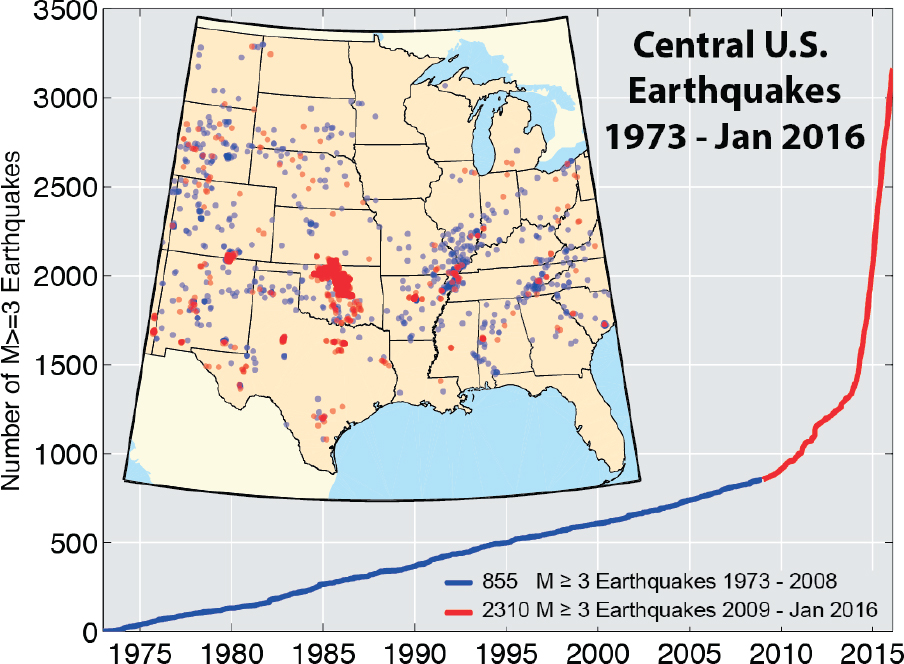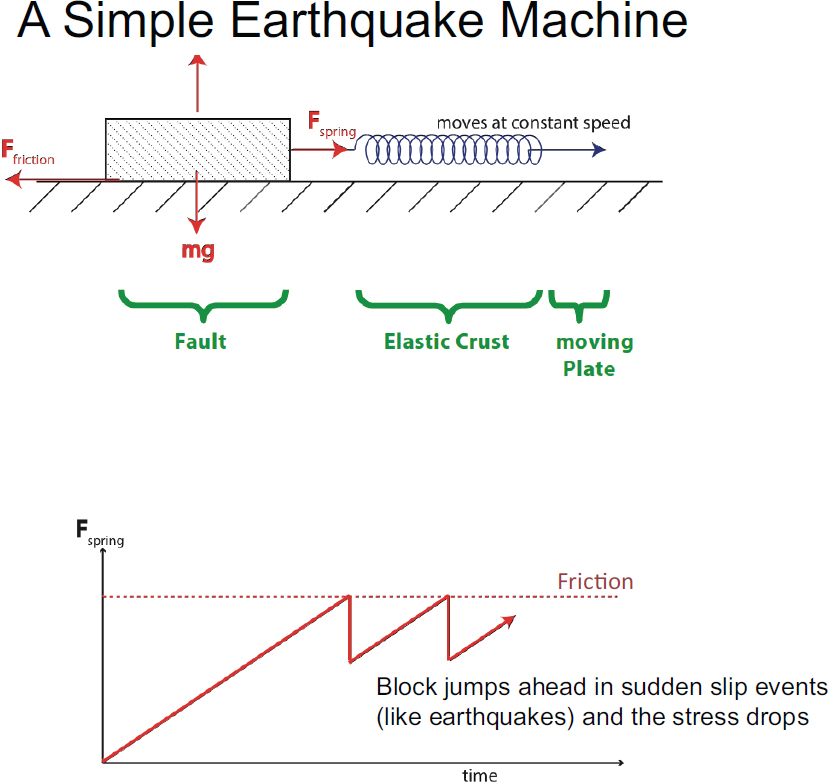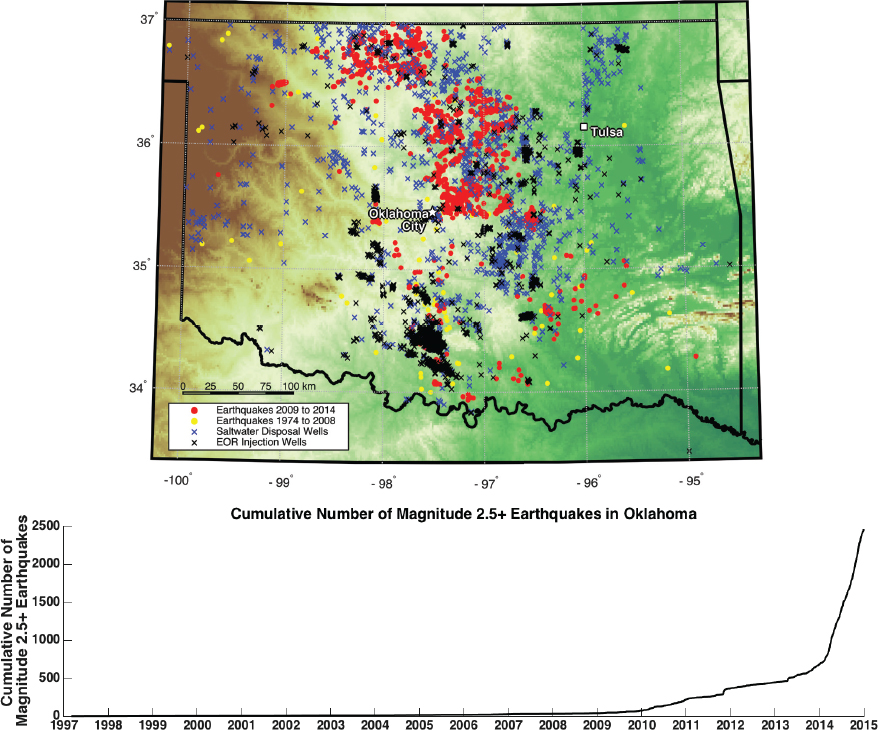2
Understanding Induced Seismicity and Managing Risk
KEYNOTE PRESENTATION
Mark Zoback, Stanford University
Beginning in about 2005, the dual practice of combining technology for horizontal drilling and multi-stage fracturing into low permeability (“tight”) natural gas-bearing rock formations began to yield significant amounts of natural gas that had previously not been economic to produce, Zoback began. By 2009, the use of these technologies had expanded into tight oil-bearing rock formations, allowing production of oil from these reservoirs.1 As greater numbers of oil and gas fields were being produced using these unconventional technologies in the period from 2009 to 2010, the background rate of earthquakes in the United States began to deviate from its long-term trend (Figure 2.1). The earthquakes causing this deviation were generally small in magnitude but were being felt in parts of the country where earthquake activity had historically not been very high, in so-called “stable” areas of continental crust typically at a significant distance from current boundaries of the major tectonic plates. These events also often occurred in proximity to oil and gas development operations.
Earthquakes actually occur along faults nearly everywhere in intraplate areas, Zoback continued, which means that the crust is critically stressed everywhere. However, the rate of earthquakes is controlled by the deformation rate of the crust, not just the stress level. The fact that the load from water reservoirs behind major dams around the globe has caused induced seismicity indicates that very small pore pressure perturbations in the crust are possible, even in intraplate (“tectonically stable”) areas.
___________________
1 Note that the use of these new combinations of technologies led to the use of the term ‘unconventional’ to refer generally to these oil and gas fields and the technologies used to produce the hydrocarbons they contain. ‘Unconventional’ was applied to differentiate from the use of more commonly used vertical drilling techniques applied to ‘conventional’ oil and gas reservoirs. Conventional reservoirs typically do not require additional engineered stimulation to allow the oil or gas to flow to the well bore.

Zoback described an earthquake in terms of a block sliding on a plane attached to a spring (Figure 2.2). As the force on the spring builds, the stress also builds until the frictional strength (or resistance) along the plane is reached and the block jumps forward, releasing the stress. In an analogous way, when stress in the Earth’s crust reaches its frictional strength along a fault such as the San Andreas where two tectonic plates are moving relative to one another, the fault slips, causing an earthquake, and then the process of building stress along the fault begins again. Faults exist everywhere in the crust, including in intraplate areas, he continued. On intraplate faults this type of slip can occur every few thousand years. However, if the frictional strength on a fault is lowered, which changing the pore fluid pressure in the rock surrounding and along the fault can do, the fault may slip earlier than it might otherwise have done from the accumulation of purely geological stress. Manmade changes in pore fluid pressure (from injection of fluids into the crust, for example) can thus cause earthquakes to take place along critically stressed faults in advance of the time they might otherwise have slipped due to geological factors alone.

In the case of oil and gas development, Zoback described the generation of induced earthquakes under three different circumstances. The most common triggering mechanism for induced earthquakes from fluid injection is related to the disposal of produced water from oil and gas operations. Produced water may be generated either from conventional oil and gas wells or from wells that have been developed with unconventional technologies (the combination of horizontal drilling and hydraulic fracturing). The second situation involves microearthquakes which are generated in the vicinity of the horizontal well bore when hydraulic fracturing takes place. These earthquakes are very small with magnitudes on the order of minus two which is equivalent to a one-meter patch of a fault that slips about a
tenth of a millimeter. The energy generated from fault slip of that scale is comparable to the amount of energy of a gallon of milk falling off a kitchen counter, Zoback said, and cannot be felt by people at the surface. The third situation may involve hydraulic fracturing itself, which has in rare situations in the United States generated earthquakes that could be felt at the Earth’s surface. The best-studied case of hydraulic fracturing causing positive magnitude earthquakes in the United States was near Youngstown, Ohio where a potentially active fault in crystalline basement2 was accidentally drilled; when the operators pressurized the zone during hydraulic fracturing, the fault slipped, causing several earthquakes ranging between magnitude 1.7 and 2.2 (Friberg et al., 2014). Zoback emphasized that the process of hydraulic fracturing very rarely causes felt earthquakes in the United States but has occurred slightly more often in western Canada and referred to the panel presentations later in the program by Shawn Maxwell and Stuart Venables (see Chapter 3).
Focusing the remainder of his presentation on induced earthquakes related to disposal of wastewater, Zoback indicated that the issue has been most marked in Oklahoma where prior to 2009 the state had about one tectonically-generated earthquake of magnitude 4 (M4) every decade. In late 2015 and 2016, one of these M4 events was being felt in Oklahoma every week (Figure 2.3). This recent, widespread seismicity in Oklahoma correlates with widespread fluid injection related to disposal of produced water from conventional oil wells; the rock formations producing oil, such as the Mississippi Lime, have very high natural water content which returns to the surface with the oil.
In cases where operators are practicing enhanced oil recovery (EOR), the produced water that comes to the surface with the oil is returned to the same formation from which it originated in order to help force additional oil out of the formation. Oil and water are initially removed from the reservoir, but because water is then returned to the formation, the result is generally an overall decrease in the reservoir pressure. In situations where EOR is not taking place and the produced water is managed through deep-well injection for disposal, the water may be injected into a rock formation other than the one in which production is taking place. In Oklahoma, produced water is usually injected for disposal into the sedimentary Arbuckle formation, which is not being produced for oil or gas. Zoback said over a period of about five years, on the order of several billion barrels of saltwater (wastewater) were injected for disposal in the Arbuckle formation (e.g. Walsh and Zoback, 2015). However, the earthquakes are not originating in the Arbuckle formation but rather in the crystalline basement rock directly underlying the Arbuckle. The injection zone in the Arbuckle is separated from the deeper basement faults from which the earthquakes originate by 3 to 4 kilometers on average, he said. The Arbuckle formation is extremely permeable, thus the produced water can spread far into the formation upon injection, resulting in very little pressure increase in the formation itself. If the injection rate exceeds a certain limit—perhaps ten million barrels of water per month—the analysis of Zoback and colleagues shows an increase, though small, in the pore fluid pressure in the Arbuckle formation and a correlation with seismically active areas (Figure 1.5; Walsh and Zoback, 2015). The key factors to generating the earthquakes in Oklahoma are therefore a combination of injection rates, permeability of the rock formation into which the water is being injected, and the nature of the contact between the wastewater injection zone and the underlying basement rock which contains the earthquake-producing faults. The fluids injected into the permeable, Arbuckle formation spread through that rock unit and may find potentially active basement faults in critical states of stress and at proper orientations to generate earthquakes that can
___________________
2 The geological term ‘basement’ generally refers to the Earth’s crust below sedimentary rocks and is usually composed of igneous and metamorphic rock types.

be felt at the surface. Pressure diffuses through the formation from the subsurface fluid injection, and the pressure increase from injection can cause a critically-stressed fault to slip (see also Walsh and Zoback, 2015).
Identification and avoidance of potentially active basement faults is important for managing the risk of inducing earthquakes from fluid injection. The earthquake hazard, Zoback indicated, depends on whether or not the injection of wastewater for disposal in the sedimentary rock is potentially going to activate faults in the underlying basement. He referred to the work of Horton and colleagues in Arkansas where fluid injection into sedimentary units, related to disposal of wastewater from oil and gas production, generated earthquakes in the underlying basement, the largest of which was M4.7 (Horton, 2012). Earthquake shaking relates to the magnitude of the earthquake, which in turn is related to the magnitude of slip on the fault. To generate a damaging earthquake (generally of M5 or greater), slip has to occur on a sizeable fault. To generate an earthquake of M5, the fault dimension has
to be on the order of 5 to 6 kilometers. For a M5.8 earthquake, the fault slip has to be on the order of 10 to 20 kilometers. The only way to have faults of this size, Zoback said, is for the faults to occur in the crystalline basement and the key to avoid inducing earthquakes of significant magnitude is to avoid pressurization of these faults from fluid injection.
Faults exist throughout the crystalline basement but at any given time only a small subset of these faults is in the proper orientation relative to the surrounding crustal stress field to have the potential to slip and generate an earthquake. The other faults are not likely to be activated due to a change in fluid pressure. Using a probabilistic assessment, Zoback then described how the uncertainty of each key variable—local crustal stresses, fault orientation and geometry, frictional coefficient on a fault, and pore fluid pressure—can be evaluated and the probability that a fault might slip with a given fluid pressure perturbation can be estimated (Walsh and Zoback, 2016). At a minimum, he suggested, such analysis may make it possible to identify which faults are not likely to slip. He also underscored the importance of having adequate and accurate fault maps; the M5.8 Pawnee earthquake in Oklahoma in 2016 occurred on a previously unidentified basement fault whose existence and orientation were only determined after analyzing the radiated seismic energy from the main earthquake shock. Zoback said that the software he and colleagues used to conduct this kind of analysis has been put online to allow geomechanical analysis of a particular area, including its faults, based on knowledge of the local stress field.3
Zoback concluded by discussing additional approaches for managing the risk of producing induced seismic events from fluid injection activities. In Pennsylvania, operators typically recycle their flowback water, avoiding the need to inject the water for disposal, thereby removing an earthquake-triggering mechanism. Using the produced or flowback water for an EOR project may also be an option in some cases. These approaches, however, are not viable for the very large amounts of water produced from formations such as the Mississippi Lime in Oklahoma. In cases where injection for disposal is required, he suggested that proactive approaches can be successful if they combine diligent monitoring of fluid pressure and seismic activity during injection with a set of established actions to reduce fluid pressure and/or stop injection if a certain seismic threshold is reached. Such mitigation approaches mandate cooperation and communication between regulators and well operators; he noted the work between state regulators and operators in Ohio as a successful example of such an approach (see also the Day 1 volume and panel presentation by Eric Vendel).
Decreasing the rate and volume of wastewater injection has led to a decrease in the rate of earthquakes in Oklahoma since 2015, Zoback noted (Langenbruch and Zoback, 2016). The reduction in volume was due to a combination of state directives to operators to decrease the volume of wastewater injection and economic factors (lower production of oil and gas due to low prices). Nonetheless, he continued, while the earthquake rate may decrease, the earthquake hazard itself does not disappear. This statistical phenomenon is exemplified by the fact that the M5.8 Pawnee earthquake and the M5.0 Cushing earthquake in Oklahoma occurred after the reduction in the wastewater injection rate in the state in 2015. The underlying reason some earthquake risk will continue in such an area after injection decreases or ceases is due to the fact that many billions of barrels of water were pumped into the Arbuckle formation over many years and the fluid pressure will take some time to re-equilibrate. The model he outlined from the Langenbruch and Zoback (2016) paper is one that can be recalibrated over time with new earthquake data to better constrain the rate of this decay.
___________________
MODERATED DISCUSSION
A participant asked Zoback to comment upon the role of scientists in communicating information about induced seismicity to the public and particularly in cases like Oklahoma, to state government officials, regulators, and industry. Zoback responded by indicating he has had a series of highly collegial and productive interactions over several years with decision makers in Oklahoma. He clarified that his role and the role of scientists, in general, is to talk with regulators and other decision makers to explain the science of what is known and not known about these events but to allow the regulators to do their jobs, as well. He underscored that regulators and others in decision-making roles often have to interpret the science in the context of many other factors including addressing public concerns and dealing effectively with the oil and gas community.
Related to a question about the fluid pressures he had discussed in the Arbuckle formation, Zoback clarified that the fluid pressures are measurable (perhaps around 300 pounds per square inch [psi]) but are nonetheless much lower than the pressures at which hydraulic fracturing, for example, takes place (which can be on the order of 3000 psi). He also clarified, in response to another question, that the statistical model he discussed is a means to evaluate the potential for a fault to slip—to identify potentially problematic faults—but did not say anything about the magnitude of any induced earthquakes. The size of an earthquake is controlled not only by the size of the fault, he explained, but by the history of the earthquakes on that fault before it was perturbed, which is essentially unknowable information. To make accurate predictions of the potential magnitude of an induced seismic event would require information about a fault that does not exist; thus, the model does not try to predict magnitude.
A participant raised the point of the importance of mapped faults as boundary conditions to help refine local pressure changes in the vicinity of fluid injection. Zoback agreed and explained further that the models he discussed are based on the idea that fluid pressure in the Arbuckle is primarily displaced laterally and some of that fluid pressure finds a permeable fault in the basement. The permeability of the Arbuckle is very high so the fluid pressure spreads fairly effectively, he continued. This kind of unique situation makes Oklahoma a bit different from other cases of induced seismicity where a close association exists between the injection point and the earthquakes. Oklahoma is enigmatic because the events seem to occur over a large area, but he and his colleagues reason that this is due to the injection itself occurring over such a large area and into a very permeable formation. A high priority for improving models is to develop better fault maps.
One participant raised the point about how to ensure that science continues to inform regulatory processes and decision making especially in cases where the scientific understanding and models are continuously evolving. Zoback responded that science has to inform regulation and that the scientific community has to make clear that the models being used are based on principles that are well established and for which a broad consensus exists. Important also is to explain to different audiences that the scientific process is one of constant criticism, correction, improvement, and moving forward. Science has a responsibility, he said, to work with and provide information to regulators and others in the community so that they can make the most informed decisions.
This page intentionally left blank.








